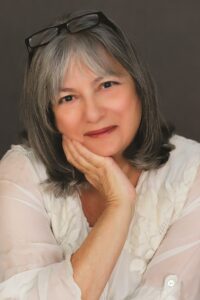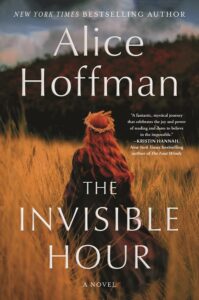Alice Hoffman’s short story titled “Property Of” was published in the prestigious literary journal American Review: The Magazine of New Writing in 1975 when Hoffman was 23. I read the story then and was impressed by its portrayal of girls whose denim jackets identified them as the “property of” the boys in a street gang.

Ted Solotaroff, the American Review’s legendary editor, had asked Hoffman if she had a novel to show him and she had said, “Yes!” and started writing it that day. Her first novel, Property Of, came out in 1977. The New York Times called it “a remarkably envisioned novel, almost mythic in its cadences, hypnotic….”
I was one of Alice Hoffman’s first fans, but I didn’t meet her until around 1985. By then she had published her fifth novel, Fortune’s Daughter. We have been friends ever since. She has now written more than 30 works of fiction. We shared the stage for a recent program at the Boston Athenaeum marking the publication of her latest novel, The Invisible Hour, an echoing meditation on Nathaniel Hawthorne’s The Scarlet Letter, written in the form of a contemporary woman’s struggle for freedom from the puritanical rules set by men.
Hoffman’s persistent themes are the betrayal of women by men, the complex relationships between mothers and daughters, and the willing suspension of disbelief — the magic — that her writing enables readers to experience. In The Invisible Hour, the magic involves time travel. “Every novel,” she said, “is an experience of time travel when the reader enters into and becomes engaged by a fictional world.”
The new novel begins with a two-page note addressed “Dear Reader.” She introduces her own mother, who was a social worker, and the suburban Long Island world she grew up in whose conservative 1950s values made them outcasts.
“When I first read The Scarlet Letter,” Hoffman writes, “it pierced my heart and helped me to understand my mother in a deeper way.” The fictional hero of her book discovers Hawthorne’s novel in her town library and understands that “it was the book that had kept her alive, the one that seemed to tell the story of her mother’s life, the one she’d always imagined had been written for her.”
The Scarlet Letter and The Invisible Hour are both about women who, in spite of being punished for becoming pregnant, chose to give birth to and raise “illegitimate” daughters. In the preface to Hawthorne’s novel, he writes this ominous caution: “But the past is not dead. Once in a great while the thoughts, that had seemed so vital and so active, yet had been put to rest so quickly, revived again.”
In Hoffman’s novel, a similar warning is sounded. The daughter is told this about her mother: “She was only a girl, … Remember that. But she should have had the choice to decide what to do with her own body and her own fate. … I fear that time is with us again, and women don’t have the right to make decisions about their own bodies.”
In our conversation, Hoffman spoke of her distress over the reversal of Roe v. Wade. She described rereading Hawthorne’s novel and discovering in a fresh way the author’s respect for and generosity toward women. In her research, she learned that Nathaniel Hawthorne was descended from one of the judges in the Salem witch trials in the 1640s — the only one, Hoffman said, who refused to apologize for sentencing those women to death. She believes that this shame moved Hawthorne, 200 years later, to write his novel.

Hoffman’s regard for Hawthorne also led her to make him a living character in her book. Her portrait of the author as a young man is a boldly imaginative move that lets readers enter Hawthorne’s own creative process. It’s the magic that Alice Hoffman fans count on.
The Invisible Hour pays tribute to libraries and their essential role of introducing readers to the books that will sustain them throughout their lives. The Boston Athenaeum appears in the novel as a refuge, and Hoffman says that at the Salem Athenaeum Hawthorne read 1,000 books in 12 years. In our conversation, she talked about her own reliance on her town librarian’s encouragement to explore as far and wide as she wished and about learning that “in every fairy tale the girl who is saved is the one who rescues herself.”
Another reason for making public libraries and librarians the heroes of her novel, Hoffman told us, was to argue against the current wave of censorship and book banning that is threatening the freedom to read.
In an Alice Hoffman novel, the natural world is always vividly real and often given symbolic power. In this novel, for example, Massachusetts apples appear in various forms to represent the “original sin” for which Eve continues to be blamed. But when asked whether her evocative portrayal of the natural world in this novel was intended to evoke the Transcendentalist values that may have influenced Hawthorne, the author’s straightforward answer was that she finds nature a form of consolation, probably because, as she put it, she grew up in a world without trees.
In The Invisible Hour, Alice Hoffman powerfully reaffirms Hawthorne’s 1850 warning: “The past is not dead.” The correspondences between her novel and The Scarlet Letter are profound, and the experience of reading the two books together is both illuminating and troubling.
Alexandra Marshall’s most recent book, a memoir, is The Silence of Your Name: The Afterlife of a Suicide. She lives in Boston and Wellfleet.



